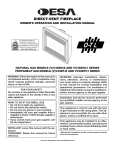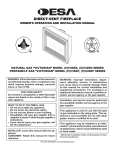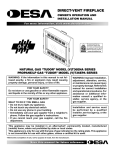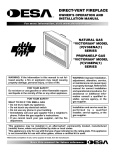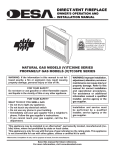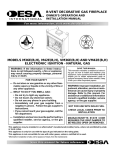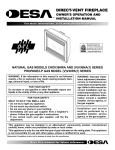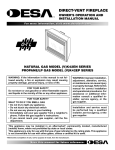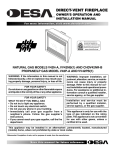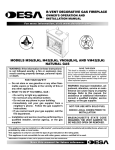Download Desa (V)DVC36(B)(H) User's Manual
Transcript
DIRECT-VENT CHASSIS OWNER’S INSTALLATION INSTRUCTIONS Patent Pending MODELS (V)DVC36(B)(H) AND (V)DVC42(B)(H) For Use with DVM series Burner modules Installation and service must be performed by a qualified installer, service agency or the gas supplier. WARNING: Improper installation, adjustment, alteration, service or maintenance can cause injury or property damage. Refer to this manual for correct installation and operational procedures. For assistance or additional information consult a qualified installer, service agency or the gas supplier. This appliance may be installed in an aftermarket,* permanently located, manufactured (mobile) home, where not prohibited by local codes. * Aftermarket: Completion of sale, not for purpose of resale, from the manufacturer State of Massachusetts: The installation must be made by a licensed plumber or gas fitter in the Commonwealth of Massachusetts. INSTALLER: Leave this manual with the appliance. CONSUMER: Retain this manual for future reference. For more information, visit www.desatech.com Table of Contents Safety Information................................................ 2 Local Codes......................................................... 3 Product Identification............................................ 3 Product Features.................................................. 3 Pre-Installation Preparation.................................. 4 Location of Termination Cap................................. 6 Venting Installation Instructions............................ 7 Replacement Parts............................................. 16 Technical Service............................................... 17 Accessories........................................................ 17 Illustrated Parts Breakdown and Parts List........ 18 Warranty Information............................Back Cover Safety Information IMPORTANT: Read this owner’s manual carefully and completely before trying to assemble, operate or service this fireplace. Improper use of this fireplace can cause serious injury or death from burns, fire, explosion, electrical shock and carbon monoxide poisoning. WARNING: Any change to this fireplace or it’s controls can be dangerous. Do not modify this fireplace under any circumstances. Any parts removed for servicing must be replaced prior to operating fireplace. WARNING: Do not use a blower insert, heat exchanger insert or other accessory not approved for use with this fireplace. WARNING: Do not allow fans to blow directly into the fireplace. Avoid any drafts that alter burner flame patterns. Due to high temperatures, the appliance should be located out of traffic and away from furniture and draperies. Do not place clothing or other flammable material on or near the appliance. Never place any objects on the appliance. Do not use this fireplace to cook food or burn paper or other flammable material. This fireplace reaches high temperatures. Keep children and adults away from hot surface to avoid burns or clothing ignition. Fireplace will remain hot for a time after shutdown. Allow surface to cool before touching. Carefully supervise young children when they are in the room with fireplace. Keep the area around your fireplace clear of combustible materials, gasoline and other flammable vapor or liquids. Do not run fireplace where these are used or stored. 1. Never install the fireplace • in a recreational vehicle • in windy or drafty areas where curtains or other combustible (flammable) objects can make contact with the fireplace front • in high traffic areas 2. Turn appliance off and let cool before servicing, installing or repairing. Only a qualified service person should install, service or repair this fireplace. Have fireplace inspected annually by a qualified service person. www.desatech.com 118197-01C Safety information Continued 3. You must keep control compartments, burners and circulating air passages clean. More frequent cleaning may be needed due to excessive lint and dust from carpeting, bedding material, etc. Turn off the gas valve and pilot light before cleaning fireplace. 4. Have venting system inspected annually by a qualified service person. If needed, have venting system cleaned or repaired. 5. Do not use any solid fuels (wood, coal, paper, cardboard, etc.) in this fireplace. Use only the gas type indicated on fireplace nameplate. 6. This appliance, when installed, must be electrically grounded in accordance with local codes or, in the absence of local codes, with the National Electrical Code, ANSI/NFPA 70 or the Canadian Electrical Code, CSA C22.1. 7. Do not use fireplace if any part has been exposed to or under water. Immediately call a qualified service person to arrange for replacement of the unit. 8. Do not operate fireplace if any log is broken. 9. Do not operate fireplace with glass door removed, cracked or broken. 10. Provide adequate clearances around air openings. Local Codes Install and use fireplace with care. Follow all local codes. In the absence to local codes, use the current National Fuel Gas Code ANSI Z223.1/NFPA 54* (USA) or the current CSA-B149.1 Installation Code (Canada). *Available from: American National Standards Institute, Inc. 1430 Broadway New York, NY 10018 National Fire Protection Association, Inc. Batterymarch Park Quincy, MA 02269 118197-01C Product Identification Upper Louver Panel Flue Collar Nailing Flange Glass Door Assembly Lower Louver Panel Switch Bracket for Optional Remote and Blower Figure 1 - Direct-Vent Fireplace Product Features These are a few facts that can help you understand and enjoy your direct-vent fireplace: • The venting system may be routed to the outside of your home in several ways. It may vent through the roof (vertical) or it may vent to an outside/exterior wall (horizontal). The vent pipe installation is very important to allow for proper operation. You must follow the venting instructions very carefully for either vertical or horizontal applications. • This fireplace may be installed in any room of your house provided all local codes and these installation instructions are followed. • This fireplace requires a wall switch, hand-held remote or wall thermostat (millivolt) for operation (see Accessories, page 42). • The use of a blower requires electricity if installed. If you plan to install the blower at a later date, outlet at bottom of fireplace must be wired during framing. • Your direct-vent gas fireplace system (fireplace and venting) is a balanced and sealed gas operating unit. It requires approximately 10-20 minutes of operating time before the flame pattern stabilizes. www.desatech.com Pre-Installation Preparation Location and space requirements Determine the safest and most efficient location for your DESA direct-vent fireplace. Make sure that rafters and wall studs are not in the way of the venting system. Choose a location where the heat output is not affected by drafts, air conditioning ducts, windows or doors. Figure 2 shows some common locations. Be aware of all restrictions and precautions before deciding the exact location for your fireplace and termination cap. When deciding the location of your fireplace, follow these rules: • Do not connect this fireplace venting to a chimney flue serving a separate solid-fuel burning fireplace or appliance. • Due to high temperatures, do not locate this fireplace in high traffic areas, windy or drafty areas or near furniture or draperies. • Proper clearances must be maintained. • If your fireplace is to be installed directly on carpeting, vinyl tile or any combustible material other than wood, it must be installed on a metal or wood panel extending the full width and depth of the fireplace. See Figure 3. • Your fireplace is designed to be used in zero clearance installations. Wall or framing material can be placed directly against any exterior surface on the back, sides or top of your fireplace, except where standoff spacers are integrally attached. If standoff spacers are attached to your fireplace, these spacers can be placed directly against wall or framing material. See framing details on page 5. • If you plan on installing a television or entertainment center recessed above your fireplace, it is recommended that you maintain a minimum 18" above top of louver opening. • When locating termination cap, it is important to observe the minimum clearances shown in Figure 7, page 8. • If recessing into a wall, you can avoid extra framing by positioning your fireplace against an already existing framing member. • Do not recess termination cap into a wall or siding. • You may paint the termination cap with 450ºF heat-resistant paint to coordinate with the exterior finish. • There must not be any obstruction such as bushes, garden sheds, fences, decks or utility buildings within 24" from the front of the termination cap. • Do not locate termination cap where excessive snow or ice build up may occur. Be sure to clear vent termination area after snow falls to prevent accidental blockage of venting system. When using snow blowers, do not direct snow towards vent termination area. Flush with a wall Through exterior wall enclosed in a chase Corner installation Figure 2 - Common Fireplace Locations 21 1/8" (36") 23 1/4" (42") 29" (36") 1 36RW /4" (42") D 41" (36") FW 48" (42") Figure 3 - Fireplace Bottom Dimensions Clearances Minimum clearances to combustibles for the fireplace are as follows: *Back and sides 0" Perpendicular walls 6" Floor 0" Ceiling to louver opening 42" Front 36" Top of Standoffs 0" Vent (See venting instructions for specific venting clearances.) Combustible material with a maximum thickness of 5/8" may be flush with the top front of fireplace. * For back and sides of fireplace, do not pack with insulation or other materials. Zero inch clearance to combustible materials are for framing purpose only. www.desatech.com 118197-01C Pre-Installation Preparation Continued B 15" C 5/8" 49 D 3 10 /8" 35 / " A3 4 NOTICE: This fireplace is intended for use as supplemental heat. Use this fireplace along with your primary heating system. Do not install this fireplace as your primary heat source. If you have a central heating system, you may run system’s circulating blower while using fireplace. This will help circulate the heat throughout the house. In the event of a power outage, you can use this fireplace as a heat source. 133/4" E F 41" 1 G /4" 41 68 / " 36" Models 1 C 58 /2" D 1 13 /2" 21B5/8" 41 / " A5 8 163/4" F 48" 48G1/4" E framing and finishing Figure 4 shows typical framing of this fireplace. Figure 5 shows framing for corner installation. All minimum clearances must be met. For available accessories for this fireplace, see Accessories on page 17. If you are using a separate combustible mantel piece, refer to Figure 6 for proper installation height. You can install noncombustible mantels at any height above the fireplace. Note: Noncombustible mantels may discolor! Nailing Nailing Tabs Tabs H1 2 Nailing Tabs Nailing Tabs 81H1/2" 42" Models Figure 5 - Framing Clearances for Corner Installation 1 2 3 A 4 B Wall 5 C D 6 E 7 F G Top of Louver Opening 361/8" (36") 401/8" (42") 411/4" (36") 481/4" (42") 21" Hor. Vent Ref. 241/2" Vert. Vent 36" 1 2 42" 23"1 Hor. Vent 3 26 /2" Vert. Vent Figure 4 - Framing Clearances for Installation Against an Exterior Wall 4 5 6 7 Mantel Depth 14" 12" 10" 8" 6" 4" 2" Ref. A B C D E F G Mantel from Top of Louver Opening 16" 14" 12" 10" 8" 6" 4" Figure 6 - Clearances for Combustible Mantels 118197-01C www.desatech.com Location of Termination Cap N N D H V L E B C Fixed Closed F B Openable Fixed Closed V Openable V I V G B V B B J V G X G M A V K X V A V TERMINATION CAP X AIR SUPPLY INLET G GAS METER RESTRICTED AREA (TERMINATION PROHIBITED) A = clearance above grade, veranda, porch, deck, or I = clearance to service regulator vent outlet [*72" (182.9 cm) balcony [*12" (30.5 cm) minimum] minimum] B = clearance to window or door that may be opened J = clearance to non-mechanical air supply inlet to building [6" (15 cm) min. for 10,000 Btu or less; 9" (23 cm) in US or the combustion air inlet to any other fireplace if between 10,000 and 50,000, 12" (30 cm) in Canada [6" (15 cm) min. for 10,000 Btu or less; 9" (23 cm) in US if between 10,000 and 100,000; 12" (30 cm) in US if if between 10,000 and 50,000, 12" (30 cm) in Canada greater than 50,000, 36" (91 cm) in Canada if greater if between 10,000 and 100,000; 12" (30 cm) in US if than 100,000] greater than 50,000, 36" (91 cm) in Canada if greater C = clearance to permanently closed window than 100,000] [minimum 12" (30.5 cm) recommended to prevent K = clearance to a mechanical air supply inlet [*In Canada, condensation on window] 6 ft. (1.83m) minimum; In US 3 ft. (91 cm) above if within D = vertical clearance to ventilated soffit located above the 10 ft. (3 m) horizontally] terminal within a horizontal distance of 24" (61 cm) from L = † clearance above paved side-walk or a paved driveway the center-line of the terminal [18" (45.7 cm) minimum] located on public property [*84" (213.3 cm) minimum] E = clearance to unventilated soffit [12" (30.5 cm) minimum] M = clearance under veranda, porch, deck F = clearance to outside corner (see below) [*12" (30.5 cm) minimum ‡] G = clearance to inside corner (see below) N = clearance above a roof shall extend a minimum of H = *not to be installed above a meter/regulator assembly 24" (61 cm) above the highest point when it passes within 36" (91.4 cm) horizontally from the center line through the roof surface and any other obstruction within of the regulator a horizontal distance of 18" (45.7 cm) † vent shall not terminate directly above a side-walk or paved driveway which is located between two single family dwellings and serves both dwellings* ‡ only permitted if veranda, porch, deck or balconey is fully open on a minimum of 2 sides beneath the floor* * as specified in CAN/CSA B149 (.1 or .2) Installation Codes (1991) for Canada and U.S.A. Note: Local codes or regulations may require different clearances Termination Clearances for Buildings with Combustible and Noncombustible Exteriors Inside Corner Outside Corner Recessed Location D C A C E A = 6" (15.2 cm) V V V B = 6" (15.2 cm) B Balcony with No Side Wall Balcony with Perpendicular Side Wall H G V V J G = 12" (30.5 cm) minimum clearance Combustible & Noncombustible H = 24" (61 cm) J = 20" (50.8 cm) C = Maximum depth of 48" (121.9 cm) for recessed location D = Minimum width for back wall of recessed location Combustible - 38" (965 mm) Noncombustible - 24" (61 cm) E = Clearance from corner in recessed locationCombustible - 6" (15.2 cm) Noncombustible - 2" (5.1 cm) Figure 7 - Minimum Clearances for Termination Cap www.desatech.com 118197-01C Venting Installation Instructions NOTICE: Read these instructions completely before attempting installation. These models are tested and approved for use with DESA (direct-vent) pipe components and terminations. The venting system must terminate on the outside of the structure and can not be attached to a chimney or flue system serving a separate solid fuel or gas burning appliance. A direct-vent appliance must have its own venting system. DO NOT common vent this appliance. These models are approved to be vented either horizontally through an outside wall or vertically through a roof or chase enclosure using the following guidelines: • When venting system terminates horizontally on an outside wall, you may install a standoff if the termination cap is to be installed directly on a combustible finish such as vinyl, wood, stucco, etc. • Never run the vent downward as this may cause excessive temperatures which could cause a fire. • Vent pipe air space clearances to combustibles are 1" on all sides except on the horizontal sections, which requires 2" clearance from the top of the pipe. Where the termination cap penetrates a combustible wall, 1" air space clearance is required. • Snorkel terminations are required when minimum clearance to grade cannot be met (see Figure 16 on page 11). • Have fireplace and selected vent components on hand to help determine the exact measurements when elbowing or offsetting. Always use wall firestops when penetrating walls and firestops when penetrating ceilings or attic spaces. • If using a venting configuration of only horizontal venting with no vertical run, a 1/4" rise for every 12" of run toward the termination is required. • For installation of fireplace at elevations of 4000 feet or greater, pay special attention to venting requirement recommendations. 118197-01C WARNING: Read all instructions completely and thoroughly before attempting installation. Failure to do so could result in serious injury, property damage or loss of life. NOTICE: Failure to follow these instructions will void the warranty. NOTICE: Do not seal termination cap to vent pipe. Cap must be removable for vent inspection and maintenance. Installation Precautions • Wear gloves and safety glasses for protection • Use extreme caution when using ladders or when on roof tops • Be aware of electrical wiring locations in walls and ceilings The following actions will void the warranty on your venting system: • Installation of any damaged venting component • Unauthorized modification of the venting system (Do not cut or alter vent components) • Installation of any component part not manufactured or approved by DESA • Installation other than as instructed by these instructions WARNING: This gas fireplace and vent assembly must be vented directly to the outside. The venting system must NEVER be attached to a chimney serving a separate solid fuel burning appliance. Each direct-vent gas appliance must use a separate vent system. Do not use common vent systems. WARNING: Vent pipe air space clearances to combustibles are 1" on all sides except on the horizontal sections, which require 2" clearances from the top of the pipe. Where the termination cap penetrates a combustible wall, 1" air space clearance is required. www.desatech.com Venting Installation instructions Continued INSTALLATION PLANNING There are two basic types of direct-vent installation: • Horizontal Termination • Vertical Termination Horizontal Termination Installation IMPORTANT: Horizontal square terminations require only inner portion of wall firestop. Horizontal installations using round termination require exterior portion of wall firestop (see Figure 14, page 10. 1. Set the fireplace in its desired location and determine the route your horizontal venting will take. Do not secure the fireplace until all venting has been installed. Some installations require sliding the fireplace in and out of position to make final venting connections. Figures 14 through 18 on pages 10 through 12 show different configurations for venting with horizontal termination that will help you decide which application best suits your installation. Check to see if wall studs or roof rafters are in the path of your desired venting route. If they are, you may want to adjust the location of the fireplace. 2. Direct vent pipe sections and components are designed with special twist-lock connections. Twist-Lock Procedure: The female ends of the pipes have locking lugs (indentations). These lugs will slide straight into matching slots on the male ends of adjacent pipes. Push pipe sections together and twist one section clockwise approximately one-quarter turn until the sections are fully locked (see Figure 8). Note: Horizontal runs of vent must be supported every three feet. Use wall straps for this purpose. 3. Use a 45° elbow to connect venting system to fireplace flue collar. The elbow is designed to be twist-locked onto the flue collar as described in step 2. IMPORTANT: Do not attempt to alter the configuration of the elbow by cutting, twisting, bending, etc. 4. Assemble the desired combination of pipe and elbows to the fireplace flue collar. If there are long portions of venting run, pre-assembled pipe sections may be installed as subassemblies for convenience. 5. Carefully determine the location where the vent pipe assembly will penetrate the outside wall. The center of the hole should line up with the center-line of the horizontal vent pipe. Mark the wall for a 10 3/4" x 10 3/4" square hole. Cut and frame the square hole in the exterior wall where the vent will be terminated. If the wall being penetrated is constructed of noncombustible material, such as masonry block or concrete, a 8 1/2" hole with zero clearance is acceptable (see Figure 9). Female Locking Lugs Male Slots Figure 8 - Vent Pipe Connections Vent Opening Combustible Wall 10 3/4" Inside Framing 10 3/4" 10 3/4" Vent Opening Noncombustible Wall (Framing Detail) 8 1/2" Center of Hole Figure 9 - Vent Opening Requirements www.desatech.com 118197-01C Venting Installation instructions Continued Vent Cap WARNING: Do not recess vent termination into any wall. This will cause a fire hazard. 6. Noncombustible Exterior Wall: Position the horizontal vent cap in the center of the 8 1/2" round hole and attach to the exterior wall with four wood screws provided. Before attaching the vent cap to exterior wall, run a bead of non-hardening mastic (pliable sealant) around the outside edges to make a seal between it and the outside wall. Note: The four wood screws provided should be replaced with appropriate fasteners for stucco, brick, concrete or other types of sidings. Combustible Exterior Wall: For vinyl siding, stucco or wood exteriors, a siding standoff may be installed between the vent cap and exterior wall. The siding standoff prevents excessive heat from damaging the siding materials. Siding material must be cut to accommodate standoff. Bolt the vent cap to the standoff. Apply non-hardening mastic around outside edge of standoff. Position the standoff/cap assembly in the center of the 10 3/4" square hole and attach to exterior wall with wood screws provided (see Figure 11). The siding standoff must sit flush against the exterior fascia material. 7. Combustible Exterior Wall Only: Slide the wall firestop over the vent pipe before connecting horizontal run to vent cap (see Figure 12). 8. Carefully move fireplace, with vent assembly attached, toward wall and insert vent pipe into horizontal termination. The pipe overlap should be a minimum of 11/4" (see Figure 13, page 10). 9. Combustible Exterior Wall Only: Slide wall firestop against interior wall surface and attach with screws provided. See Figure 13, page 10, for horizontal termination details. 10. Place fireplace into position and shim with noncombustible material if needed. Nail or screw side flanges to framing to secure unit in place. IMPORTANT: Make sure fireplace is level before securing. If fireplace is not level it will not work properly. 118197-01C Wood Screw Figure 10 - Installing Horizontal Vent Cap (Noncombustible Exterior) Cut Siding Away to Fit Standoff Standoff Wood Screw Vent Cap Apply Mastic to All Four Sides Screws Figure 11 - Installing Siding Standoff (Combustible Exterior Wall) Interior Wall Surface Wall Firestop Vent Cap (Horizontal Termination) Horizontal Vent Pipe Figure 12 - Connecting Vent Cap with Horizontal Vent Pipe www.desatech.com Screw Venting Installation instructions Continued Minimum Pipe Overlap 11/4" Direct-Vent Pipe Siding Standoff Screws Wall Firestop GROUND FLOOR INSTALLATION Recommended Applications: • Installation using cabinet surrounds • Through the wall using round or square termination (up to 12" horizontal pipe) • NOT FOR CORNER INSTALLATION Adjustable Horizontal Pipe 12" Max. High Wind Square Termination 45° Elbow Wall Firestop Maintain 1" Minimum Air Space Around Outer Pipe When Penetrating a Wall High Wind Termination Apply Mastic to Outside 10 3/4" x 10 3/4" Edge of Framed Opening Standoff Exterior Wall with Vinyl Siding Figure 13 - Typical Horizontal Termination Cap Mounting with Additional Siding Standoff Installed Square Termination WARNING: Never run vent downward as this may cause excessive temperatures which could cause a fire. Operation of improperly installed and maintained venting system could result in serious injury, property damage or loss of life. 10 Horizontal (H) 32 3/4" min. 17" max. 45° Elbow Wall Firestop Horizontal Termination Configurations Figures 14 through 18 show different configurations and alternatives for venting with horizontal termination. Each figure includes a chart with critical minimum and maximum dimensions which MUST be met. IMPORTANT: If using a venting configuration of only horizontal venting with no vertical run, a 1/4" rise for every 12" of run toward the termination is required. NOTICE: Do not seal termination cap to vent pipe. Cap must be removable for vent inspection and maintenance. Vertical (V) Exterior Portion of Wall Firestop (Round Termination Only) Horizontal Round Termination Round Termination * If installing this fireplace at altitudes of 4000 feet and above, it is recommended that an additional vertical height of 6" be added to the vent system. Figure 14 - Horizontal Termination Configuration for Square or Round Terminations www.desatech.com 118197-01C Venting Installation instructions Continued CORNER INSTALLATION Recommended Applications: • Corner ground floor installation • Ground floor installation where pipe vents horizontally through wall (over 12" horizontal pipe) • Basement installation where one foot clearance from ground to termination is possible Not to Exceed (H) Limits 90° Elbow Square Termination Not to Exceed (H) Limits 90° Elbow Wall Firestop As Required for (V), See Chart for Pipe Section Required Square Termination 12" Min. 45° Elbow Wall Firestop Vertical (V) Required Vertical Pipe Horizontal (H) *43 1/2" min. 54 1/2" min. 66 1/2" min. 78 1/2" min. 90 1/2" min. None 1 ft. 2 ft. 3 ft. 4 ft. 30" max. 48" max. 60" max. 84" max. 20' max. 45° Elbow * Ground Floor Corner Venting Figure 15 - Horizontal Termination Configuration for Corner Installation Using One 90° Elbow SNORKEL TERMINATION INSTALLATION Recommended Applications: • Installations requiring a vertical rise on building exterior • Any installation using snorkel termination to achieve one foot above ground Snorkel terminations are available for installations requiring a vertical rise on the exterior of the building. If installing snorkel termination below grade, you must provide proper drainage to prevent water from entering snorkel termination (see Figure 16). Do not back fill around snorkel termination. Snorkel Termination Wall Snorkel Termination Firestop Snorkel Termination 90° Elbow 12" Min. 12" Min. 12" Min. 45° Elbow Adequate Drainage Figure 16 - Snorkel Termination Configurations for Below Ground Installation 118197-01C www.desatech.com 11 Venting Installation instructions Continued HORIZONTAL SYSTEM INSTALLATION USING TWO 90° ELBOWS The following configurations show the minimum vertical rise requirements for a horizontal system using two 90° elbows. 45° Elbow Venting with Two 90° Elbows Horizontal (H1) + Vertical (V) Horizontal (H1) Horizontal (H2) 5' min. 6' min. 7' min. 8' min. 20' max. 2' max. 4' max. 6' max. 8' max. 8' max. 6' max. 12' max. 18' max. 20' max. 20' max. Figure 17 - Horizontal Termination Configuration for Venting Using Two 90° Elbows Venting with Two 90° Elbows Horizontal (H1) + Horizontal (H2) Vertical (V) 5' min. 6' min. 7' min. 8' min. 20' max. 6' max. 12' max. 18' max. 20' max. 20' max. 45° Elbow Figure 18 - Horizontal Termination Configuration for Venting Using Two 90° Elbows with Termination at 90° with Fireplace 12 www.desatech.com 118197-01C Venting Installation instructions Continued installation for vertical termination Note: Vertical restrictor must be installed in all vertical installations. 1. Determine the route your vertical venting will take. If ceiling joists, roof rafters or other framing will obstruct the venting system, consider an offset (see Figure 19) to avoid cutting load bearing members. Note: Pay special attention to these installation instructions for required clearances (air space) to combustibles when passing through ceilings, walls, roofs, enclosures, attic rafters, etc. Do not pack air spaces with insulation. Also note maximum vertical rise of the venting system and any maximum horizontal offset limitations. 2. Set the fireplace in desired location. Drop a plumb line down from the ceiling to the position of the fireplace exit flue. Mark the center point where the vent will penetrate the ceiling. Drill a small locating hole at this point. Drop a plumb line from the inside of the roof to the locating hole in the ceiling. Mark the center point where the vent will penetrate the roof. Drill a small locating hole at this point. Roof Flashing Wall Strap Flat Ceiling Installation 1. Cut a 10 3/4" square hole in the ceiling using the locating hole as a center point. The opening should be framed to 10 3/4" x 10 3/4" (27.3 cm x 27.3 cm) inside dimensions, as shown in Figure 9 on page 8 using framing lumber the same size as the ceiling joists. If the area above the ceiling is an insulated ceiling or an attic space, nail firestop from the top side. This prevents loose insulation from falling into the required clearance space. If the area above the ceiling is a living space, install firestop below the framed hole. The firestop should be installed with no less than three nails per side (see Figure 20). 2. Assemble the desired lengths of pipe and elbows necessary to reach from the fireplace flue up through the firestop. Be sure all pipe and elbow connections are fully twist-locked (see Figure 8, page 8). 3. Cut a hole in the roof using the locating hole as a center point. (Cover any exposed open vent pipes before cutting hole in roof.) The 10 3/4" x 10 3/4" hole must be measured on the horizontal; actual length may be larger depending on the pitch of the roof. There must be a 1" clearance from the vent pipe to combustible materials. Frame the opening as shown in Figure 9, page 8. 4. Connect a section of pipe and extend up through the hole. Note: If an offset is needed to avoid obstructions, you must support the vent pipe every 3 feet. Use wall straps for this purpose (see Figure 19). Whenever possible, use 45° elbows instead of 90° elbows. The 45° elbow offers less restriction to the flow of the flue gases and intake air. If area above is an attic space or insulated area, install firestop above framed hole. 45° Elbow If area above is a living space, install firestop below framed hole. Ceiling Firestop Figure 19 - Offset with Wall Strap and 45° Elbows Figure 20 - Installing Firestop 118197-01C www.desatech.com 13 Venting Installation instructions Continued 5. Place the flashing over the pipe section(s) extending through the roof. Secure the base of the flashing to the roof and framing with roofing nails. Be sure roofing material overlaps the top edge of the flashing as shown in Figure 19, page 13. There must be a 1" clearance from the vent pipe to combustible materials. 6. Continue to add pipe sections until the height of the vent cap meets the minimum building code requirements described in Figure 7 on page 6. Note: You must increase vent height for steep roof pitches. Nearby trees, adjoining rooflines, steep pitched roofs and other similar factors may cause poor draft or down-drafting in high winds. Increasing the vent height may solve this problem. 7. Twist-lock the vent cap onto the last section of vent pipe. Note: If the vent pipe passes through any occupied areas above the first floor, including storage spaces and closets, you must enclose pipe. You may frame and sheetrock the enclosure with standard construction material. Make sure and meet the minimum allowable clearances to combustibles. Do not fill any of the required air spaces with insulation. Vertical Termination Configurations Figures 21 through 24 show four different configurations for vertical termination. Venting with Two 90° Elbows Horizontal (H1) + Vertical (V) Horizontal (H2) 5' min. 6' min. 7' min. 8' min. 20' max. 2' max. 4' max. 6' max. 8' max. 8' max. 45° Elbow Note: Install restrictor into inner collar of fireplace as shown. Figure 21 - Vertical Venting Configuration Using Two 90° Elbows with Two Horizontal Runs (Vertical Round High Wind Termination Shown) Venting with One 90° Elbow Vertical (V) Horizontal (H) 5' min. 6' min. 7' min. 8' min. 20' max. 2' max. 4' max. 6' max. 8' max. 8' max. 45° Elbow Note: Install restrictor into inner collar of fireplace as shown. Figure 22 - Vertical Venting Configuration Using One 90° Elbow (Vertical Round High Wind Termination Shown) 14 www.desatech.com 118197-01C Venting Installation instructions Continued Vertical Venting V = 40' max. Note: Install restrictor into inner collar of fireplace as shown. 45° Elbow 45° Elbow Venting with Two 90° Elbows Vertical (V1) Horizontal (H) 5' min. 6' min. 7' min. 8' min. Note: Install restrictor into inner collar of fireplace as shown. 6' max. 12' max. 18' max. 20' max. Figure 24 - Vertical Venting Configuration With No Horizontal Run (Vertical Round High Wind Termination Shown) Note: Vertical (V1) + Vertical (V2) = 40' max. Figure 23 - Vertical Venting Configuration Using Two 90° Elbows (Vertical Round High Wind Termination Shown) 118197-01C www.desatech.com 15 Venting Installation instructions Continued parts list for venting kits and components DESA (5"/8") Pipe & Vent Kits Number Description P58-6 6" Section Double Wall Pipe, Galvanized P58-12 12" Section Double Wall Pipe, Galvanized P58-2424" Section Double Wall Pipe, Galvanized P58-36 36" Section Double Wall Pipe, Galvanized P58-48 48" Section Double Wall Pipe, Galvanized PA58-712 Adjustable 7"-12" Section Double Wall Pipe, Galvanized E58-45 45° Elbow, Galvanized E58-90 90° Elbow, Galvanized VKG-58 Ground Floor Vent Kit, Galvanized (Includes: 45° Elbow, 7"-12" Adjustable Pipe, Wall Firestop, Horizontal Square Termination, 16 Screws) VKB-58 Basement Vent Kit, Galvanized (Includes: 45° Elbow, 7"-12" Adjustable Pipe, Wall Firestop, Horizontal Square Termination, 4' Pipe, 90° Elbow, 20 Screws) VKS-58 Snorkel Vent Kit, Galvanized (Includes: 45° Elbow, 7"-12" Adjustable Pipe, Wall Firestop, 36" Snorkel Termination, 4' Pipe, 1' Pipe, 90° Elbow, 26 Screws) VKR-58 R o o f Ve n t K i t , G a l v a n i z e d (Includes: 45° Elbow, 7"-12" Adjustable Pipe, Flue Restrictor, Vertical High Wind Termination, 2' Pipe, 4' Pipe, Wall Firestop, Storm Collar, Roof Flashing [0/12 - 6/12], 26 Screws) VKC-58 Corner Vent Kit, Galvanized (Includes 45° Elbow, 7"-12" Adjustable Pipe, Wall Firestop, Horizontal Termination, 6" Pipe, 90° Elbow, 18 Screws) HHTK-58 High Wind Round Horizontal Termination Kit (Includes Round Termination, Wall Firestop, 45° Elbow) 16 Number HHT-58 HTS-58 HTKS-58 VT-58 ST-58-14 ST-58-36 SC-58 WF-58 RF-58-6 RF-58-12 VR-58 S-58 WS-58 CS-58 FP-58 SF-58 RF-58 Description High Wind Round Horizontal Termination Kit, Galvanized Horizontal Square Termination, Galvanized Horizontal Square Termination Kit (Includes: Square Termination, Wall Firestop, 45° Elbow) Vertical Round Termination, Galvanized 14" Snorkel Termination, Galvanized 36" Snorkel Termination, Galvanized Storm Collar, Galvanized Wall Firestop, Galvanized Roof Flashing - 0 to 6/12 Pitch, Galvanized Roof Flashing - 6/12 to 12/12 Pitch, Galvanized Vertical Restrictor, Galvanized Vinyl Siding Standoff, Galvanized Wall Strap Cathedral Ceiling Support Firestop Plate Stucco Flashing For use with HTS-58 Flat Roof Flashing Replacement Parts Note: Use only original replacement parts. This will protect your warranty coverage for parts replaced under warranty. Parts Under Warranty Contact authorized retailers of this product. If they can not supply original replacement part(s), call DESA’s Customer Service Department at 1-866-672-6040. When calling DESA, have ready • your name • your address • model and serial numbers of your fireplace • how fireplace was malfunctioning • type of gas used (propane/LP or natural gas) • purchase date Usually, we will ask you to return the part to the factory. www.desatech.com 118197-01C Replacement Parts Continued Parts Not Under Warranty Contact authorized retailers of this product. If they can not supply original replacement part(s), call DESA at 1-866-672-6040 for referral information. When calling DESA, have ready • model number of your fireplace • the replacement part number Technical Service You may have further questions about installation, operation or troubleshooting. If so, contact DESA’s Customer Service Department at 1-866-672-6040. When calling, please have your model and serial numbers of your heater ready. You can also visit DESA’s technical service web site at www.desatech.com. Accessories Notice: All accessories may not be available for all fireplace models. Purchase these fireplace accessories from your local retailer. If they can not supply these accessories, call DESA’s Sales Department at 1-866-672-6040 for information. You can also write to the address listed on the back page of this manual. Brick Liner Kit (Not Shown) BL36DA - Textured Refractory BL36DSA - Standard Refractory BL36DHA - Textured Refractory Herringbone BL36DHSA - Standard Refractory Herringbone BL42DA - Textured Refractory BL42DSA - Standard Refractory BL42DHA - Textured Refractory Herringbone BL42DHSA - Standard Refractory Herringbone This brick liner adds a touch of style to your directvent fireplace. Complete installation instructions included in this manual. Face/Louver Panel kit (Not Shown) 118197-01C FPD36 - Filigree, Black FPD36B - Filigree, Brushed Brass FPD36P - Filigree, Platinum FPD36PB - Filigree, Polished Brass RLD42 - Rolled Louver, Black FPD42 - Filigree, Black FPD42B - Filigree, Brushed Brass FPD42P - Filigree, Platinum FPD42PB - Filigree, Polished Brass Louver trim kit (Rolled Louvers Only) (Not Shown) LT36B - Brushed Brass LT36P - Platinum LT36PB - Polished Brass LT42B - Brushed Brass LT42P - Platinum LT42PB - Polished Brass Deflection hoods (Not Shown) HD36 - Black (2" Brow) HD42 - Black (2" Brow) Perimeter Trim kit (Not Shown) PT36 - Black PT36B - Brushed Brass PT36P - Platinum PT36PB - Polished Brass PT42 - Black PT42B - Brushed Brass PT42P - Platinum PT42PB - Polished Brass Manual blower Kit - BK Manual variable control blower accessory provides better heat distribution. Complete installation and operation instructions included in this manual. Thermostaticallycontrolled blower kit - BKT Provides better heat distribution. Blower turns off and on automatically, as needed. Complete installation and operation instructions included in this manual. www.desatech.com 17 Illustrated Parts Breakdown Models (V)DVC36(B)(H) and (V)DVC42(B)(H) 6 7 8 4 1 9 11 3 10 18 19 12 17 13 2 14 16 15 5 18 www.desatech.com 118197-01C PARTS LIST Models (V)DVC36(B)(H) and (V)DVC42(B)(H) This list contains replaceable parts used in your fireplace. When ordering parts, follow the instructions listed under Replacement Parts on page 16 of this manual. KEY NO. 1 2 3 (V)DVC36(B)(H) (V)DVC42(B)(H) DESCRIPTION ** ** 108010-01 — 108011-01 108011-02 ** ** ** 109082-01 24460 See Below See Below See Below 108719-01 12105 11418 14123 21171 24353 4 5 6 7 8 9 10 11 12 13 14 15 16 17 18 19 QTY. 1 1 1 1 1 1 1 1 1 1 1 1 1 1 1 2 2 1 2 1 27253 ** Firebox Assembly ** Face Weldment 108328-01 Door Assembly 108328-02 Door Assembly (V Models Only) 108331-01 Top Louver Assembly 108331-02 Bottom Louver Assembly ** Fireplace Top ** Fireplace Top Insulation ** Fireplace Surround 109082-02 Heat Shield 24460 Gas Conduit Assembly See Below Left Refractory Brick Panel See Below Rear Refractory Brick Panel See Below Right Refractory Brick Panel 108455-01 Screen Rod 107840-01 Screen 11418 Push-On Nut 14123 Strain Relief 21171 Gas Knock-Out Cover 24353 Handy Box Assembly PARTS AVAILABLE - NOT SHOWN 27253 Notice Label 55240 55240 1 1 Vent Label REFRACTORY BRICK PANELS PART NO. 110989-02 111215-02 111299-02 111302-02 110989-01 111215-01 111299-01 111302-01 110991-02 111217-02 111297-02 111330-02 110991-01 111217-01 111297-01 111300-01 110990-02 111216-02 111298-02 111301-02 110990-01 111216-01 111298-01 111301-01 118197-01C DESCRIPTION Left Refractory Brick Panel Left Refractory Brick Panel Left Refractory Brick Panel Left Refractory Brick Panel Left Refractory Brick Panel Left Refractory Brick Panel Left Refractory Brick Panel Left Refractory Brick Panel Rear Refractory Brick Panel Rear Refractory Brick Panel Rear Refractory Brick Panel Rear Refractory Brick Panel Rear Refractory Brick Panel Rear Refractory Brick Panel Rear Refractory Brick Panel Rear Refractory Brick Panel Right Refractory Brick Panel Right Refractory Brick Panel Right Refractory Brick Panel Right Refractory Brick Panel Right Refractory Brick Panel Right Refractory Brick Panel Right Refractory Brick Panel Right Refractory Brick Panel DVC 36B DVC 36H DVC 42B DVC 42H VDV C36 B VDV C36 H VDV C42 B VDV C42 H ** Part not available for field replacement. • • • • • • • • • • • • • • • • • • • www.desatech.com • • • • • QTY 1 1 1 1 1 1 1 1 1 1 1 1 1 1 1 1 1 1 1 1 1 1 1 1 19 Warranty Information KEEP THIS WARRANTY Model Serial No. Date Purchased Always specify model and serial numbers when communicating with the factory. We reserve the right to amend these specifications at any time without notice. The only warranty applicable is our standard written warranty. We make no other warranty, expressed or implied. LIMITED WARRANTY DIRECT-VENT FIREPLACE DESA warrants this product to be free from defects in materials and components for two (2) years from the date of first purchase, provided that the product has been properly installed, operated and maintained in accordance with all applicable instructions. To make a claim under this warranty the Bill of Sale or cancelled check must be presented. This warranty is extended only to the original retail purchaser. This warranty covers the cost of part(s) required to restore this heater to proper operating condition and an allowance for labor when provided by a DESA Authorized Service Center. Warranty part(s) MUST be obtained through authorized retailers of this product and/or DESA who will provide original factory replacement parts. Failure to use original factory replacement parts voids this warranty. The heater MUST be installed by a qualified installer in accordance with all local codes and instructions furnished with the unit. This warranty does not apply to parts that are not in original condition because of normal wear and tear or parts that fail or become damaged as a result of misuse, accidents, lack of proper maintenance or defects caused by improper installation. Travel, diagnostic cost, labor, transportation and any and all such other costs related to repairing a defective heater will be the responsibility of the owner. TO THE FULL EXTENT ALLOWED BY THE LAW OF THE JURISDICTION THAT GOVERNS THE SALE OF THE PRODUCT; THIS EXPRESS WARRANTY EXCLUDES ANY AND ALL OTHER EXPRESSED WARRANTIES AND LIMITS THE DURATION OF ANY AND ALL IMPLIED WARRANTIES, INCLUDING WARRANTIES OF MERCHANTABILITY AND FITNESS FOR A PARTICULAR PURPOSE TO TWO (2) YEARS ON ALL COMPONENTS FROM THE DATE OF FIRST PURCHASE; AND DESA’S LIABILITY IS HEREBY LIMITED TO THE PURCHASE PRICE OF THE PRODUCT AND DESA SHALL NOT BE LIABLE FOR ANY OTHER DAMAGES WHATSOEVER INCLUDING INDIRECT, INCIDENTAL OR CONSEQUENTIAL DAMAGES. Some states do not allow a limitation on how long an implied warranty lasts or an exclusion or limitation of incidental or consequential damages, so the above limitation on implied warranties or exclusion or limitation on damages may not apply to you. This warranty gives you specific legal rights and you may also have other rights that vary from state to state. For information about this warranty write: 2701 Industrial Drive P.O. Box 90004 Bowling Green, KY 42102-9004 www.desatech.com 118197 01 NOT A UPC 118197-01 Rev. C 10/06





















